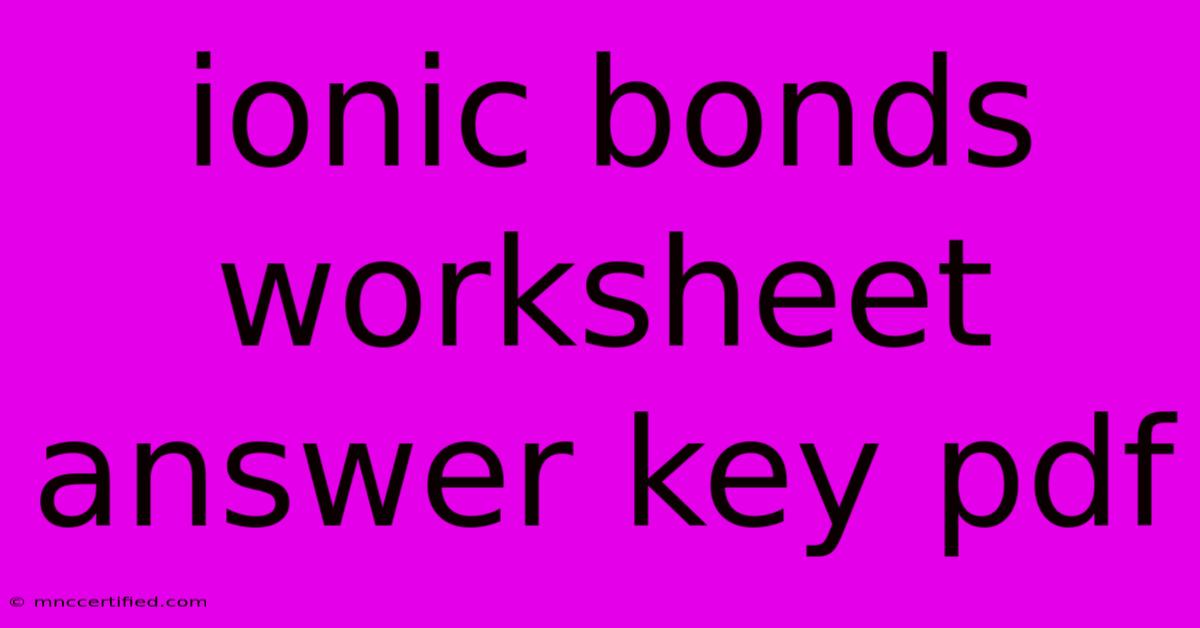Ionic Bonds Worksheet Answer Key Pdf

Table of Contents
Ionic Bonds Worksheet Answer Key: Master the Fundamentals of Chemical Bonding
Understanding ionic bonds is crucial for a solid foundation in chemistry. This worksheet provides a comprehensive overview of ionic bonding, covering key concepts and addressing common misconceptions. Use this answer key to check your understanding and solidify your knowledge.
What are Ionic Bonds?
Ionic bonds are formed when a metal atom transfers one or more electrons to a nonmetal atom. This transfer results in the formation of charged particles called ions. The metal atom becomes a positively charged cation, while the nonmetal atom becomes a negatively charged anion.
Key Characteristics of Ionic Bonds:
- Electrostatic Attraction: The opposite charges of the cation and anion create a strong electrostatic attraction, holding them together in a crystal lattice.
- High Melting and Boiling Points: The strong electrostatic forces require a lot of energy to break, leading to high melting and boiling points.
- Conductivity: Ionic compounds conduct electricity when dissolved in water or melted, as the ions are free to move.
- Solubility: Many ionic compounds dissolve in water, as the polar water molecules can surround and separate the ions.
Worksheet Practice: Ionic Bond Formation
Let's practice forming ionic bonds with the following examples. Refer to the periodic table for the charges of the ions.
-
Sodium (Na) and Chlorine (Cl)
- Sodium loses one electron to become a +1 cation: Na+
- Chlorine gains one electron to become a -1 anion: Cl-
- The resulting ionic compound is Sodium Chloride (NaCl)
-
Magnesium (Mg) and Oxygen (O)
- Magnesium loses two electrons to become a +2 cation: Mg+2
- Oxygen gains two electrons to become a -2 anion: O-2
- The resulting ionic compound is Magnesium Oxide (MgO)
-
Aluminum (Al) and Sulfur (S)
- Aluminum loses three electrons to become a +3 cation: Al+3
- Sulfur gains two electrons to become a -2 anion: S-2
- To balance the charges, we need two Aluminum atoms and three Sulfur atoms: Al2S3
Understanding the Nomenclature of Ionic Compounds:
- Name the cation first, followed by the anion.
- The cation keeps its element name.
- The anion name ends in "ide".
Worksheet Practice: Naming Ionic Compounds
Name the following ionic compounds:
- KCl: Potassium Chloride
- CaO: Calcium Oxide
- Li2S: Lithium Sulfide
- FeCl3: Iron(III) Chloride
Important Note: For transition metals, which can have multiple oxidation states, we use Roman numerals in parentheses after the metal name to indicate its charge.
Off-page SEO Strategies:
- Link Building: Build high-quality backlinks from reputable websites related to chemistry and education.
- Social Media Promotion: Share your worksheet on relevant social media platforms, encouraging engagement and discussion.
- Community Forums: Participate in online forums related to chemistry and share your worksheet as a valuable resource.
By mastering the fundamentals of ionic bonds and practicing with this worksheet, you'll gain a strong foundation for understanding the fascinating world of chemistry!

Thank you for visiting our website wich cover about Ionic Bonds Worksheet Answer Key Pdf. We hope the information provided has been useful to you. Feel free to contact us if you have any questions or need further assistance. See you next time and dont miss to bookmark.
Featured Posts
-
Watch Rangers Vs Hearts Premier League Tv Guide
Nov 11, 2024
-
Will City Or Liverpool Pay 40m For Fulham Player
Nov 11, 2024
-
Patriots Dominate Bears Secure Third Win
Nov 11, 2024
-
Farmers Insurance Pre Qualifier 2024
Nov 11, 2024
-
Kellys Question Alabama Dominates Lsu
Nov 11, 2024